Italian art 1450 to 1490
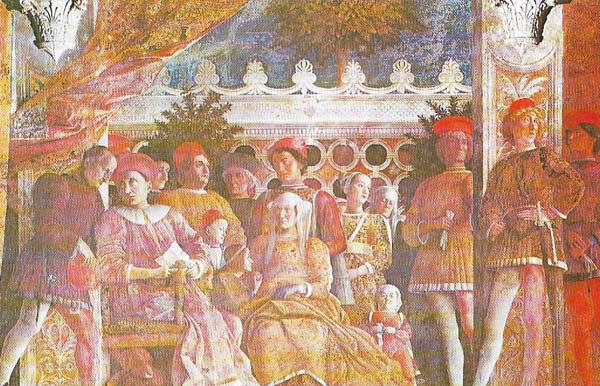
Figure 1. In Andrea Mantegna's fresco "The Gonzaga Court" (c. 1470–1474), Ludovico Gonzaga sits, surrounded by his family and court, receiving a letter. There are similar scenes on a second wall, and the ceiling is painted as an illusion with a circular opening to blue sky.

Figure 2. Villa Medici, Poggio a Caiano (Florence), was begun c. 1482 by Giuliano da Sangallo for Lorenzo de Medici and completed for Leo X c. 1520. The curved external staircase replaced the original one which comprised two simple ramps. Close to the roads into Florence from the north, the villa was intended for receptions as well as the usual rural and summer pursuits; hence, probably, its unusual size and formality.
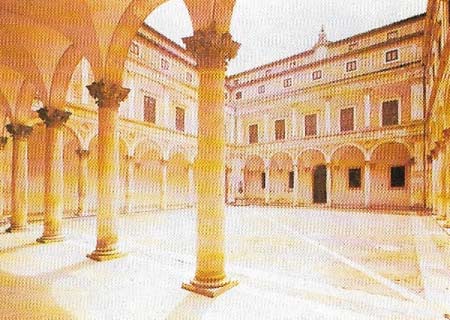
Figure 3. The courtyard, Palazzo Ducale, Urbino, was built 1464–1472 by Luciano da Laurana (fl. 1468–1482) for Federico da Montefeltro (1422–1482), warrior, statesman, scholar and patron of the arts, later first Duke of Urbino. The broad proportions and subtlety of rhythm distinguish it from Florentine courtyards; the whole palace is spacious, most refined in its sculptural decoration and placed so as to command a stupendous view.
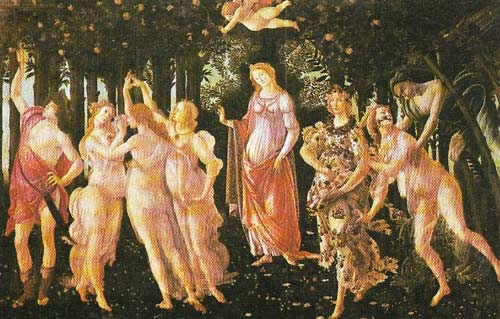
Figure 4. Sandro Botticelli's "Allegory of Spring" (c. 1478) was painted to be fixed above a couch on the town house of the young cousins of Lorenzo de Medici. The earliest secular paintings are generally either wall decoration or on furniture.
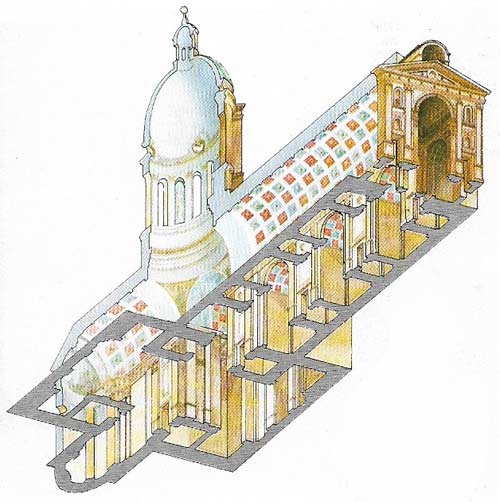
Figure 5. San Andrea, Mantua, was designed in 1470 by Alberti for Ludovico Gonzaga. Only the nave is certainly Alberti's design.
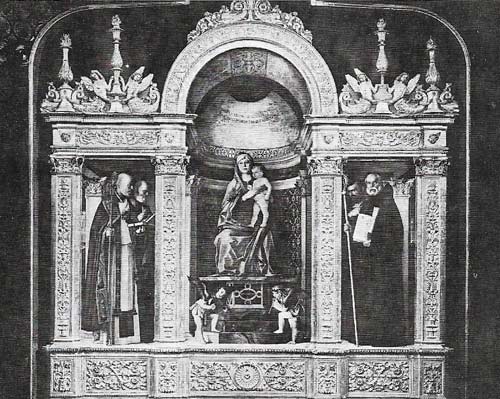
Figure 6. The "Madonna and Saints" of Bellini in S. Maria die Frari, Venice (1488), is characteristic of the artist's dignity and restraint, with especially refined description of light and resonant color. It was painted when he was turning, in his later work, to simpler more monumental forms. The classically shaped frame is original.
The stylistic revolution in Italy in the second and third decades of the fifteenth century had results that were in two crucial respects different from those that followed Duccio's and Giotto's achievements in the 14th century. First, the revolution's effects were quickly felt in almost all centres of any artistic importance; second, a profusion of artists of talent and imagination ensured that what followed was not reassessment, nor merely exploitation, but a continuing ferment of activity with a sustained momentum of exploration and invention.
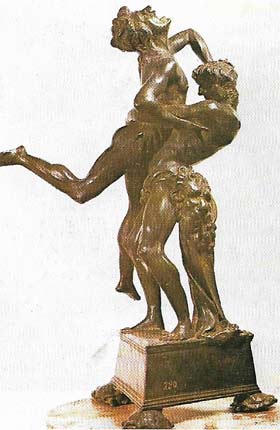 |
| Antonio Pollaiuolo's "Hercules and Antaeus", a bronze statuette c. 1470–1480, is similar in design to a small painting by Polaiuolo (1429–1498) on the same subject (Virtue) done for Medici; the bronze was also most probably in the Medici collection. Although it has a triangular base it is only intelligible from one viewpoint; the all-round view was first achieved by Verrocchio. |
Increase in secular patronage
One reason for this situation was the wider opportunity offered to artists in the second half of the century by a multiplicity of centres of patronage. These may be divided crudely into two types: on the one hand were the old nominal republics such as Florence and Venice, where a prosperous bourgeoisie with a patrician upper crust offered at least as much patronage as the state and, on the other, the petty principalities, such as Milan, Mantua, Ferrara, Rimini, Urbino and Naples, where a confused mixture of despotism and ancient aristocracy tended to focus patronage on a centre such as a court, often with pretensions, as that of the dukes of Burgundy. A long period of comparative peace made these courts – among them the special case of Rome – much more significant artistically after the mid-century, although they were never entirely separate.
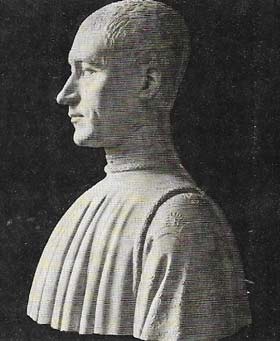 |
| Filippo Strozzi (1428–1491), the most important Florentine patron after the Medici, built a palace grander than theirs. This marble bust of him (c. 1485) is by Benedetto da Maiano. |
A change in status
These opportunities for artists were augmented by a slowly, and subtly changing attitude to the status and use of works of art. This was the period in which the battle to promote the visual arts to the level music held among the liberal arts was in general won. And independently of any philosophical change of this kind there was more lavish investment in culture for culture's sake; so if artists were not painting more fresco cycles in churches than before, they were producing more paintings and sculpture for private enjoyment. The quantity of artistic objects in domestic settings was significantly higher at the end of the century than at the beginning.
The result of these changes in demand is in harmony with new possibilities of supply that arose from technical and expressive progress; in general terms there was a wider diversity in the forms and functions of works of art in the second half of the century. The bronze statuette and the portrait-bust, for example, became firmly established in this period. These two types illustrate a general phenomenon – the meeting of new and mostly secular demands by the adaptation of earlier and mostly religious forms. The small bronze of mythological or allegorical subjects followed a long tradition of statuettes of saints and the composition of the sculptured portraits is best explained by reference to the continuing manufacture of reliquary busts. The evolution of each type was stimulated by the collecting of similar objects from antiquity. Similarly, the new large-scale secular figurative paintings, which decorated princes' palaces and patricians' houses were made possible by the painters' experience of ecclesiastical art. Thus one is reminded in Andrea Mantegna's Camera degli Sposi in the Ducal Palace, Mantua (1473–1474), of religious narrative and in Sandro Botticelli's "Allegory of Spring" (Figure 4) of a madonna and saints. More rarely – although both Mantegna (c. 1431–1506) and Botticelli (1445–1510) provide important examples – secular compositions by artists during this period are inspired by classical sculpture.
Styles of architecture
Architecture shows that diversification by cross-fertilization works in both directions. Giuliano da Sangallo (1445–1516) and Lorenzo de' Medici (1449–1492) designed at Poggio a Caiano (Figure 2) the first of the great Renaissance villas, for a lifestyle inherited from the Middle Ages and fortified by re-reading the ancients. Similarly, Giuliano's building is a blend of traditional big farm-house and selected classical elements – externally, the arched basement (recalling an amenity Pliny described in one of his villas) and the applied temple-front, a dignifying feature with a great future in domestic architecture. Conversely, the principal source of inspiration for the church designs of Leon Battista Alberti (1404–1472) was a secular form, the Roman triumphal arch.
These architectural examples also illustrate the adjustment of newly enriched styles to what were enduring problems and it is only too easy to overstate the degree of change. Churches, tombs, altarpieces and so on were of course made as prolifically as before. The diversity of styles was as great as that of art forms and showed similar vigorous continuity and change, so that generalization is unusually difficult. But in architecture it may be said that style was characterized by a more exact, complex and literate knowledge of antiquity; in sculpture and painting, on the other hand, typically in the work of the greatest sculptor of the period, Andrea del Verrocchio (c. 1434–1488), or of the greatest painter, Giovanni Bellini (c. 1430–1516) (Figure 6), the antique was not the overwhelming inspiration it had been for their predecessors Donatello and Masaccio, but was replaced by the imitation of nature. Simplicity was superseded by complexity, austerity by refinement, and in these ways late fifteenth-century Italian art reflected the structure and values of its market.
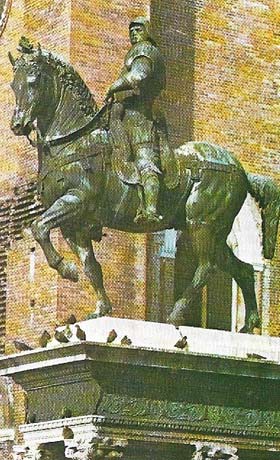 |
| Andrea Verrocchio's Colleoni Monument commemorates Bartomomeo Colleoni who was condottiere of the Venetians. Verrocchio made his competition model for the monument of Florence and moved to Venice in 1483 to execute it. It was cast, after his death (1488), by Leopardi, who also designed the base. |
